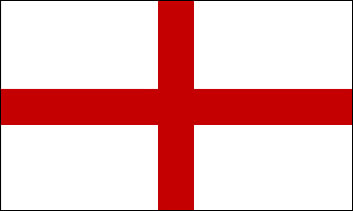April 23, 2008
Happy St. George's Day!

Today is the feast day of St. George, patron of England. Here is a summary of his life, death and patronage. Frankly, very little is known about his origins.
By coincidence, I happened to have come across the passage in Gibbon's Decline and Fall of the Roman Empire this week in which Gibbon states his belief that the original George was not a soldier around the time of Constantine, but instead one George of Cappadoccia, a villanous character and Arian heritic who warred with the great St. Athanasius over control of the Alexandrian Church. A sample of Gibbon's description:
George, from his parents and education, surnamed the Cappadocian, was born at Epiphania in Cilicia, in a fuller's shop. From this obscure and servile origin he raised himself by the talents of a parasite; and the patrons whom he assiduously flattered procured for their worthless dependent a lucrative commission, or contract, to supply the army with bacon. His employment was mean; he rendered it infamous. He accumulated wealth by the basest arts of fraud and corruption; but his malversations were so notorious, that George was compelled to escape from the pursuits of justice. After this disgrace, in which he appears to have saved his fortune at the expense of his honour, he embraced, with real or affected zeal, the profession of Arianism. From the love, or ostentation, of learning, he collected a valuable library of history, rhetoric, philosophy and theology; and the choice of the prevailing faction promoted George of Cappadocia to the throne of Athanasius. The entrance of the new archbishop was that of a barbarian conqueror; and each moment of his reign was polluted by cruelty and avarice.
Gibbon goes on for some considerable time in this vein, concluding:
The meritorious death of the archbishop obliterated the memory of his life. The rival of Athanasius was dear and sacred to the Arians, and the seeming conversion of those sectaries introduced his worship into the bosom of the catholic church. The odious stranger, disguising every circumstance of time and place, assumed the mask of a martyr, a saint, and a Christian hero; and the infamous George of Cappadocia has been transformed into the renowned St. George of England, the patron of arms, of chivalry, and of the garter.
Gibbon's assertion may be based on a mistake in his source. According to the Wiki entry on St. George,
According to the Catholic Encyclopedia, the earliest text preserving fragments of George's narrative is in an Acta Sanctorum identified by Hippolyte Delehaye of the scholarly Bollandists to be a palimpsest of the fifth century. The compiler of this Acta, according to Delehaye "confused the martyr with his namesake, the celebrated George of Cappadocia, the Arian intruder into the see of Alexandria and enemy of St. Athanasius".
But I think he was also motivated by malice. Gibbon detested the "worship" of saints, martyrs, icons and relics, believing them to be importations into the Church from paganism, fueled by the outright ban on paganism instituted by the Emperor Theodosius in the late 4th Century.
I throw it out simply for your viewing interest.
It was the apparitions of him at Antioch and Jerusalem during the Crusades that really put him on the map, so to speak, in the medieval mind. The Golden Legend stories also added to his popularity; I find that to fully understand the medieval veneration of saints, one has to realize that they viewed the Golden Legend as being a trustworthy document; we view them naturally as merely pious heroic tales along the lines of the Morte d'Arthur.
There is, of course, a paradox with regard to the saints. For instance, Nicholas of Smyrna. He is the root saint behind the legends of Santa Claus. But consider the rather substantial amount of time and thought devoted to Santa Claus, particularly by children. He is very real to them.
So much so, that I think the actual saint, in Heaven, gets Santa's mail, so to speak. Which is not to say that he has a workshop full of elves, lives at the north pole, etc., but that in the economy of salvation, I have to think the more serious petitions addressed to Santa are handled by someone. I'm thinking Nicholas of Smyrna is a very, very busy man at Christmas time.
And I have to think that he does, indeed, put on the red suit when a child dies and goes to heaven and is looking for a familiar face. In other words, I think that to some degree, our conceptions of the saints shape how and what the saint actually does. We have some input, so to speak, into their job description.
Just a speculation, of course; I don't think the Church has ever examined the question of how our conceptions of the saints affect the saints. But I have to think that St. George does indeed, fight dragons (There was a story a while back of one of Fr. Fortea's exorcisms where St. George was a particularly effective intercessor in confronting a particular demon), St. Joseph occasionally interests himself in real estate transactions, and St. Jude fights for a lost cause. Why? Because we ask them to.
Naturally, when a child asks me if I believe in Santa Claus, I can respond that I most certainly do. I don't even have to cross my fingers.
Footnotes? All the good stuff in Gibbon is in the footnotes.
Posted by: mojo at April 23, 2008 10:36 AM

 Image courtesy of the lovely and talented
Image courtesy of the lovely and talented 